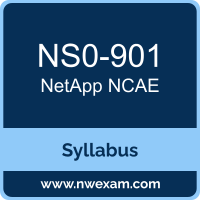 A great way to start the NetApp Certified AI Expert (AI Expert) preparation is to begin by properly appreciating the role that syllabus and study guide play in the NetApp NS0-901 certification exam. This study guide is an instrument to get you on the same page with NetApp and understand the nature of the NetApp NCAE exam.
A great way to start the NetApp Certified AI Expert (AI Expert) preparation is to begin by properly appreciating the role that syllabus and study guide play in the NetApp NS0-901 certification exam. This study guide is an instrument to get you on the same page with NetApp and understand the nature of the NetApp NCAE exam.
Our team of experts has composed this NetApp NS0-901 exam preparation guide to provide the overview about NetApp Artificial Intelligence Expert exam, study material, sample questions, practice exam and ways to interpret the exam objectives to help you assess your readiness for the NetApp AI Expert exam by identifying prerequisite areas of knowledge. We recommend you to refer the simulation questions and practice test listed in this guide to determine what type of questions will be asked and the level of difficulty that could be tested in the NetApp NCAE certification exam.
NetApp NS0-901 Exam Overview:
| Exam Name | Artificial Intelligence Expert |
| Exam Number | NS0-901 AI Expert |
| Exam Price | $250 USD |
| Duration | 90 minutes |
| Number of Questions | 60 |
| Passing Score | 66% |
| Recommended Training | NetApp Training |
| Exam Registration | PEARSON VUE |
| Sample Questions | NetApp NS0-901 Sample Questions |
| Practice Exam | NetApp Certified AI Expert Practice Test |
NetApp NS0-901 Exam Topics:
| Section | Weight | Objectives |
|---|---|---|
| AI overview |
- Demonstrate the ability to train and inference
- Describe machine learning benefits
- Differentiate the use between different algorithm types
- Describe how AI is used in varied industries
- Describe convergence of AI, high-performance computing, and analytics
- Determine the use of AI on-premises, in the cloud, and at the edge
|
15% |
| AI lifecycle |
- Determine the differences between predictive AI and generative AI
- Describe the impact of predictive AI
- Describe the impact of generative text, images, videos, decisions in Generative AI
- Determine how NetApp tools can enable data aggregating, data cleansing, data modeling
- Determine the requirements needed for model generation
- Compare the differences between model building and fine-tuning models
- Determine the requirements needed for inferencing
|
27% |
| AI Software Architectures |
- Describe AI MLOps/LLMOps ecosystems and general use
- Determine the differences between Juypter notebooks vs pipelines
- Describe how NetApp DataOps toolkit works
- Demonstrate the ability to execute AI workloads at scale with Kubernetes
- Describe the uses of BlueXP software tools to build AI solutions
|
18% |
| AI Hardware Architectures |
- Describe data aggregation topologies
- Describe compute architectures used with AI workloads
- Describe network architecture used with AI workloads
- Identify storage architectures used with AI workloads
- Determine the use cases of different protocols
- Determine the benefits of SuperPOD architectures with NetApp
- Describe the uses cases for BasePod and OVX architectures
|
18% |
| AI Common Challenges |
- Determine how to size storage and compute for training and inferencing workloads
- Describe the solutions for code, data, and model traceability
- Describe how to access and move data for AI workloads
- Describe solutions to optimize cost
- Describe solutions to secure storage for AI workloads
- Describe solutions to maximize performance in AI workloads
|
22% |
NetApp AI Expert Exam Description:
Pass the NetApp Certified AI Expert exam to stay ahead of the technology curve. Achieving this certification validates the skills and knowledge associated with NetApp AI solutions and related industry technologies.
